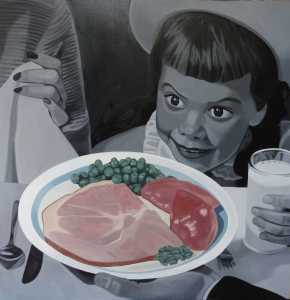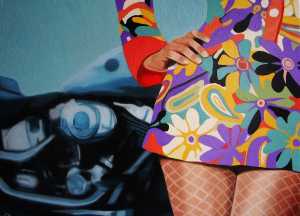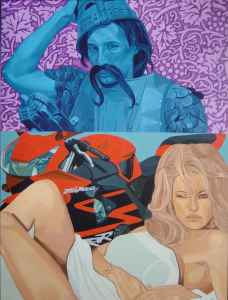Vladislav Scepanovic
Ausgewählter Künstler
kuratiert von artbynow.com
mehr ...
http://www.artmajeur.com/scepan
Kunstart: Malerei
Technik: Ölmalerei
Stil: Realismus
Statement:
großen Kriegstreiber des Jahrhunderts als anbetungswürdige Ikonen mit Heiligenschein darstellt, Khomeini als segnenden Christus, die heile Vorzeigefamilie vor dem Hakenkreuz oder als grinsende Fratzen vor Warner Brother Plakaten der Traumfabrik Hollywood. Scepanovic entwirft eine schöne bunte Welt der Grausamkeiten.
Cultural Industrie macht glücklich, wie eine unten Drogen fanatisch lächelnde junge Frau mit ungesunder Hautfarbe weiß machen will. Ein Pepsikronkorken gerät zur Aureole einer Madonna mit Kind und austauschbare Parolen ziehen sich quer durch das collagenartigen Werk. Auch jüngste Ereignisse werden kommentiert, wenn er Barak Obama vor dem Weißen Haus platziert und mit Zitaten wie he is no real black und exponent of beast versieht. Scepanovic legt mit seiner Kunst unsere Welt frei, er macht die Schichten ersichtlich, unter denen sich Massenverführung breit macht. Ob Westen oder Osten, Scepanovic zeigt: die Mechanismen sind überall die gleichen. Mit seiner Wertediskussion in Form von Bildern trifft Scepanovic mitten ins Herz unserer kranken Welt.
Redaktion:
Dr. Stefanie Lucci
Vladislav Scepanovic
Theoretical framework of my art
Through my art, I discuss the problem of the world of simulations and acting of forces of domination and resistance in the mass media spectacle. The basic motive of my work is the research of media scenes which represent an open display of the power of capital and ruling economic and political structures. The world today is not free, it may not have ever been, but this form of non-freedom, caused by the reproduction of everything in the form in which any trace of its very material substance gets lost, gradually is becoming the state of disappearance in virtual world of images and information. I started from the critics of cultural industries, consumerism, utilitarianism, solipsism, and my tools are my paintings. My painting is not only the reproduced image of mass media, it is just an element in my work carrying a subversive message. My visual criticism is the painting created manually by an artist, the one characterized by its uniqueness, endurance and material form. One of the important forms of my work is strategy propaganda vs. propaganda. Therefore, I use elements like film, advertising, fashion, or any other industry modern culture is made of, and fixing, intervening, and manually creating paintings, I contextualize understandable message of the critics of the modern world-simulacrum. Above all, my criticism is oriented towards media aesthetics which is the first echelon, the vanguard of corporative capitalism and global hegemony.
Why painting?
In the multitude of reproduced images and information, painting is, through selection, combining, installing and manual performance, capable of regaining auratism (Benjamin) and referentiality of man as an intelligent subject. And, through the return of something unique and unrepeatable, which can be attained only by overcoming virtualization and mass production, painting is able to create a work with critical purpose. Even criticism and subversion themselves, why not say destruction, related to the overall spectacularization, are a reason for such a work to become permanent. And its very identity is what makes a piece of art far more durable than spectacularized matrixes and esthetized information which devour each other, creating a world of inconsistency and simulation. Permanence is an important form of subversion and destruction in regard with society in which an individual must produce and spend frantically until is sucked into the vortex of void. The work of art is particularly important because, due to its durability, remains a critical testimony, not a mimesis of an epoch. On the other hand, too many pieces of overlapping information, as well as the lack of referentiality, make information revoke its quality as a support for interpretation and understanding of the epoch in which it was created. Therefore, such an art which contracts information, creating the critical image of the spectacle, remains the only source of freedom and critical thought, capable of overcoming the system created on the virtual and false subject.
In my opinion, sufficient approval of my thesis is that quasi modern artists today live and create their pieces of work mainly on the basis of projects they send to the institutions, which, as the representatives of the system, allocate financial means to them. Those projects are mainly connected to non material subjects (video works, technological installations, happenings, digital art, etc.), because they respond to the demands of the technological industry (artists as promoters of new technologies) and virtualization of the capital. If the economic system is based on false foundation (since 1971, US dollar is not subject to Gold Standard), if the value of a brand exceeds manifold the material value of the product, consequently the art in service of such a system must be non-material, highly technological and virtual.
My painting is a hybrid of high technology and the human, but it is not aimed at cyborgization and disappearance in machines and information, but at a call for return (or maybe creation) of consciousness and common sense. Hence, that is a road from losing the aura in the context of Walter Benjamin’s reasoning to re-auratization, not on a stable referent, but in a the full critical strength of free thought and work of art. An important feature of my work is introduction of narrative elements in my paintings. For me the painting has not only a simple meaning, but narrative as well. I achieve this narrative effect by several images with its own narrative course in one painting, or by a set of paintings connected to each other by the narrative course. My message is clearly expressed through the major impression conveyed by the painting and at the same time it articulates my notion of the contemporary world based on punctum magnetism (Bart), which is, in my opinion, necessary ingredient of art. What makes my work distinct is hand-made narration, which stands in contrast with the major part of contemporary art, based upon technical software and gadgets, ranging from digital print to computer projects. The worldwide empire of digital production, which the quasi-art of spectacle in the great part derives from, has limited time duration and vanishes together with authors and curators into the virtual void. Expiry date of such art is shorter than the lifespans of the artists themselves. One of the biggest illusions of that kind of art is experiment. Given the fact that experiments take place within the world created by programmers, technician artists, and designers, there is no room for creative surprises, divertions and brilliance which make art important. Therefore, I suppose that dealing with technological innovations is the basic and the biggest misconception of the contemporary art. As mentioned before, in the world of technological domination, virtual finances, and non-values, there has been created space for yet another paradox – the art has to be put back on the traditional track since its nature of auratic artifact serves as a counterpoint of the system. For that reason, the Stackist’s maxim, which claims that „the real artist is the only one who paints“, today, unlike some other point in time, resonates with truth. Thus, it is all about perpetual movement, changing of position which art should take towards society, in order to preserve the state of paradox, free thought as well as free emotions above all.
Conclusion
The main characteristic of my work is the aesthetics of destruction and destructivity in regard to doxis, whether it’s related to dictatorship of market and mass scenes of spectacle, or to popular religion, media manipulation, and overall aesthetization.
In that manner, the segment of destruction becomes very important factor in my art. Such art is antithesis of society. If it is observed from horizontal approach, art must be neither elitist nor the privilege of the well-educated, but understandable, critical and politically engaged. It should speak the language of mass culture, not because it represents its own choice and affirmation, but because through such a form of expression, art can produce actual results. In that way, art can pose questions to a wider auditorium and react critically right through sense excitations which are the precondition of the thinking process.
From the above mentioned, I draw a conclusion that destruction in art, unlike destruction in media, politics and market world, becomes a constructive element. It could be said that destruction in the world of art represents a form of creation. Art in modern world can exist only as destructive, critical and subversive, but definitely not as the proxy and the subject of society. In such balance of power, art which should inspire and create esthetical ideal of the society, transforms itself into its own negation and becomes a form of solipsism.
Redaktion:
Dr. Stefanie Lucci
Vita / Lebenslauf:
Bio / Resumee / Statement:
CURRICULUM VITAE
Vladislav Scepanovic was born in Niksic (Montenegro) in 1971.
He finished primary and secondary school in Belgrade.
He graduated in Faculty of Fine Arts, in 1994 in Cetinje, as a student in Profesor of Professor Ratko Lalic’s class..
He got the Master studies diploma, at Faculty of Applied Arts in Belgrade in Profesor Gradimir Petrovic’s class.
Later on He acquired an PhD diploma, at Interdisciplinary studies, University of Arts in Belgrade, mentor was PhD Divna Vuksanovic. Department of Phd is Art and Media Theory. He finished it of in 11. 11. 2009.
He works as an Associate Professor at subject drawing and painting at Faculty of Applied Arts in Belgrade.
.
He has been member of ULUS since 1994.year.
He is , at the same tame, the founder and the general editor of art association ART OF REALITY and a member of art group HARD SOC.
He is a member of HAPPY TEAM-a – council Happy Gallery at SKC in Belgrade.
He is a winner of award for painting for 2001year “BELI ANĐEO / White Angel”, Mileseva 2001.
He has been an active participant in the world of art since 1994 as an exhibiter, theoretician, organizer of art events and teaching art
He is a member of concurs board at international art festival of SKC “Aprilski Susreti / Aprile meetings 2002” in Belgrade. He has held the exhibitions in Podgorica, Belgrade, Novi Sad, Kolasin, Paris and Tokyo, as the author, and has participated at collective exhibitions in Belgrade, Podgorica, Budva, Sremski Karlovci, Vrsac and Paris.
As a student he took part in students studies excange in /London, 1995, Paris, 1998…/
He was participant at several round tables on art theory. He published the texts about art theory and philosophy in important scientific journals.
The Exhibition that should have taken place at The “Progres Gallery” was forbidden on owing to alternative views of the world and showed how little understanding toward different views there was to relation at global culture.
He is Associate Professor on Faculty of Applied Art
He is Acting Director of Museum of Contemporary Art in Belgrade since 2013.
He is president board for international art manifestation / October Saloon, since 2014.
Aktivitäten / Ausstellungen:
The most important exhibitions:
1. Painting exhibition, Gallery KNU, Belgrade, 1996.
2. Painting exhibition, Gallery Contemporary Art Center, Podgorica, 1996.
3. Happy People, Painting exhibition, Happy Gallery of SKC, Belgrade, 24.IV-7.V 1998.
4. Los Angeles-Beograd, /Jelena Markovic, Vladislav Šcepanovic, Srdjan Jile Markovic/, Gallery ULUPUDS, Beograd, 9.VI-23.VI, 1998
5. Painting exhibition, Yugoslav Cultural Center, Paris, 1998
6. Art of Reality association, First yearly promotion, painting exhibition /HARD SOC., HYPE/, lecture “Art of really danger /M. Pjescic, S.Dj.Marković/, “Pogon Doma Omladine” Belgrade, 7.VII 1999.
7. Art of Reality association, Second yearly promotion painting exhibition /HARD SOC., HYPE/, concert / Total destruction, Supernaut/, film of Igor Simonović Stadium, club Underground, Belgrade, 1.XI 1999.
8. Shadow of your Paradise, HARD SOC., painting exhibition, /V.Scepanović,V.Markoski, Jile, M. Pjescic/, Gallery 73, Belgrade, 25.XI-15.XII 1999.
9. Out of Reality, HARD SOC., HYPE, painting exhibition, gallery Belgrade, 11.V-25.V 2000.
10. Art of Real Dangers, painting exhibition /HARD SOC., HYPE/, “IV Bijenale mladih”, Vršac, July-August, 2000.
11. Art in interregnum, painting exhibition of group HARD SOC. /V.Scepanović,V.Markoski, Jile, M. Pjescic/, SKC, Belgrade,17.XI-30.XI, 2000
12. Pulp Fiction, exhibition Art Group HARD SOC./ /V.Scepanović,V.Markoski, Jile, M. Pjescic, Z. Glamocak/, Gallery KCB, Belgrade, March 2001.
13. »Passion« Painting exhibition in Art pavilion in Podgorica Novembar 2003.
14. »Passion 2« the exhibition should have taken place in gallery »Progres«, but it had been forbiden – February 2004.
15. 45th October art salon, CONTINENTAL BREAKFAST BELGRADE, 10. 09. – 31. 10. 2004.
16. »Occident Mammons Way« exhibition in gallery SKC Belgrade january 2005.
17. »Occident Mammons Way 2\\\'« exhibition in gallery Den, Tokyo,July – August 2005.
18. » Cultural industry« exhibition in gallery Vojvodjanske banke, Novi Sad, 2006.
19. »Society of Spectacle« exhibition at gallery ULUS, Belgrade, 2007.
20. »Art and Revolution«, exibition in Atelje 212, Belgrade, 12. 12. 2009.
21. »The Hard Soc again, mutherfuckers« exhibition in gallery Belgrade, Belgrade April 2010.
22. »Simulation of meaning« exhibition in gallery Fonticum, Groznjan, Croatia, May, 2012.
23. »Ownership of fate« Collective exhibition in gallery Fonticum, Groznjan, Croatia, Jun, 2012
24. »Discomfort in Culture« group exhibition in gallery Ozone, Belgrade, 2013
25. »What does Vladislav Scepanovic« exhibition in gallery Ozone, Belgrade, 2014
Published scientific papers
1.Human Rights, or Rights of passive observes, in: FILOZOFEME, Serbian philosophical forum, Novi Sad, October 2006.
2. The Conflict of generalization, in: NATIONAL INTEREST National Interest, Institute for Political Studies, Belgrade, 2007.
3. Media culture and terrorism – symbiosis of media and destruction, in: CULTURE, journal of theory and sociology of culture and cultural policy, No. 124, Belgrade, 2009.
4. Media aesthetics and destruction, in: Proceedings of the Faculty of Dramatic Arts, Belgrade, 2009¬-2010.,
5. The role of photography in promoting a society of spectacle, in: CM, journal of management communication, No. 13. 2009-2010., Faculty of Political Sciences, Belgrade.
Monography
MEDIA SPECTACLE AND THE DESTRUCTION: Aestetics Destruction and Spectacularisation realitty, Sluzbeni glasnik, Belgrade, 2010.
Symposiums, conferences, forums, :
1. International symposium, Art and Politics, Infant, 2006.Novi Sad
2. Tribune Stevan Majstorović, the Culture of Spectacle, the Institute for the study of cultural development, Serbian 2009.
3. Conference - Media, Culture and Religion. The conference will be held on 7 and 8 May 2010th Youth Center in Belgrade. With in the program of the conference the collection of scientific papers is to be issued.
The most significant projects
1. Open Spaces, exhibition of students of Faculty of Applied Arts , Belgrade, Happy Gallery SKC, Belgrade, February, 2001. The author of project: Vladislav Scepanovic
2. Suzana Pajovic, Object - Contemporary Montenegrin art scene, Happy Gallery SKC, April 2001. The author of project: Vladislav Scepanovic
3. Marica Kuznjecov/ Đorđije Boljević, paintings – Contemporary Montenegrin art scene, Happy Gallery SKC, 19.06-30.06. 2001. The author of project: Vladislav Scepanovic
4. Natalija Djuranović paintings – Contemporary Montenegrin art scene, Happy Gallery SKC, 4 - 12. October 2001. The author of project: Vladislav Scepanovic
5. Nenad Soskic, Auguste Rodin - Marcel Duchamp, photo installation - Contemporary Montenegrin art scene, Happy Gallery SKC, 1- 25. October 2001. The author of project: Vladislav Scepanovic
6. Humanitarian painting exhibition, Art Of Reality & Rotaract Belgrade, Gallery “Beograd”, Belgrade, 11.X- 20.X 2001. The author of project: Vladislav Scepanovic
7. Lecture, Walter Bergmoser /Weimar, Germany/, Faculty of Applied Arts Belgrade, 18.04.2002 The author of project: Vladislav Scepanovic
8. The students exhibitions, Towards his/her own poetics, Happy Gallery, 2009 – 2010, Author of project: The author of project: Vladislav Scepanovic
|

































